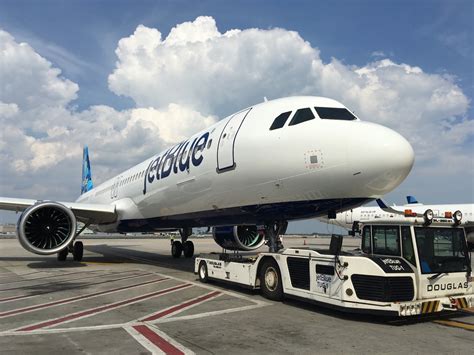
JetBlue Airways is reducing its flight schedule and cautioning about weaker-than-expected travel demand, citing ongoing economic uncertainty as a primary factor impacting consumer behavior. The airline anticipates lower revenue for the current quarter as a result of this softening demand.
JetBlue (JBLU) announced it would trim its flight capacity by a low single-digit percentage for the remainder of 2024, responding to a noticeable slowdown in bookings. This adjustment reflects a proactive approach to managing resources in light of unpredictable economic conditions. The airline’s management team stated that they observed a dip in demand during the latter part of the first quarter, leading to revised revenue expectations.
According to a statement released by JetBlue, “Economic uncertainty continues to pressure demand, resulting in lower-than-expected revenue.” The airline is closely monitoring booking trends and macroeconomic indicators to adapt its strategies accordingly.
The capacity reduction will primarily affect routes where demand has been most affected, although specific routes were not disclosed in the initial announcement. JetBlue plans to optimize its network to focus on profitable markets and manage costs effectively. The airline emphasized its commitment to providing customers with advance notice of any changes to their travel itineraries and offering alternative arrangements whenever possible.
This decision comes at a challenging time for the airline industry, which is still recovering from the impacts of the COVID-19 pandemic. While travel demand rebounded strongly in 2022 and 2023, recent economic headwinds, including inflation and concerns about a potential recession, have created uncertainty about the sustainability of this recovery. Other airlines have also reported mixed signals regarding demand, suggesting that the industry-wide outlook remains uncertain.
JetBlue is implementing several measures to mitigate the impact of reduced demand and improve its financial performance. These include cost-cutting initiatives, revenue management strategies, and efforts to enhance operational efficiency. The airline is also focusing on expanding its ancillary revenue streams, such as baggage fees and seat upgrades, to offset the decline in ticket sales.
The airline’s leadership expressed confidence in its ability to navigate the current challenges and emerge stronger in the long term. They highlighted JetBlue’s unique brand proposition, customer loyalty, and strong network as key assets that will support its future growth. JetBlue also emphasized its commitment to providing a differentiated travel experience that focuses on value and customer service.
The announcement has prompted analysts to revise their forecasts for JetBlue’s financial performance. Several investment firms have lowered their earnings estimates for the current quarter and the full year, citing concerns about the impact of reduced demand and increased competition. However, some analysts remain optimistic about JetBlue’s long-term prospects, pointing to its strong balance sheet and strategic initiatives.
JetBlue’s decision to cut flights underscores the sensitivity of the airline industry to economic conditions and consumer sentiment. As economic uncertainty persists, airlines will need to remain agile and adapt their strategies to navigate the evolving landscape. The coming months will be critical in determining the trajectory of travel demand and the overall health of the airline industry.
Impact on Consumers
The most immediate impact for consumers will be potential schedule changes, although JetBlue has pledged to minimize disruptions. Travelers should check their flight status regularly and be prepared for possible rebooking options or travel vouchers if their flights are affected. The move could also lead to slightly higher prices on some routes as capacity is reduced, although this will depend on the overall competitive landscape.
JetBlue’s Strategy
JetBlue’s strategy is multifaceted. By proactively reducing capacity, they aim to protect their yields (average fare paid per mile) and prevent prices from falling too sharply due to oversupply. This also allows them to better manage their operating costs, especially fuel and labor, which are significant expenses for airlines. Furthermore, JetBlue is likely focusing on its most profitable routes and markets to maximize revenue generation.
Broader Industry Context
JetBlue’s announcement is not isolated. Several other airlines have hinted at or taken similar actions, indicating a broader trend of softening demand. This suggests that the pent-up demand from the pandemic era is waning, and airlines are now facing a more normalized demand environment, albeit one complicated by economic uncertainties. Factors like high inflation, rising interest rates, and geopolitical instability are all contributing to this cautious outlook.
Future Outlook
The future outlook for JetBlue and the airline industry remains uncertain. The key factors to watch will be the strength of the economy, consumer confidence, and the evolution of travel patterns. JetBlue’s ability to effectively manage its costs, optimize its network, and maintain customer loyalty will be crucial to its long-term success. The airline’s planned acquisition of Spirit Airlines, which is currently under regulatory review, could also have a significant impact on its future prospects.
Long-Term Implications
This situation highlights the cyclical nature of the airline industry. Airlines are highly sensitive to economic fluctuations, and periods of strong growth are often followed by periods of consolidation and restructuring. JetBlue’s proactive approach to managing capacity and costs suggests that it is well-prepared to weather the current challenges. However, the long-term implications will depend on the severity and duration of the economic slowdown. The company will need to continue to innovate and adapt to maintain its competitive edge in a rapidly changing industry.
Deeper Dive into the Numbers
While the Yahoo Finance article does not provide specific numbers regarding the percentage of flight reductions or the expected revenue decline, it is reasonable to assume that these figures are being closely monitored by analysts and investors. The airline’s upcoming earnings report will likely provide more detailed information about its financial performance and its outlook for the remainder of the year. Investors will be paying close attention to key metrics such as revenue per available seat mile (RASM), cost per available seat mile (CASM), and load factor (percentage of seats filled) to assess the airline’s profitability and efficiency.
The Spirit Airlines Factor
The pending acquisition of Spirit Airlines (SAVE) adds another layer of complexity to JetBlue’s situation. The deal, which is currently facing regulatory scrutiny from the Department of Justice, would significantly expand JetBlue’s network and market share. However, it also carries significant risks, including integration challenges, potential cost overruns, and the possibility that the deal will be blocked by regulators. The softening demand environment could make the integration of Spirit Airlines even more challenging, as JetBlue would need to find ways to generate sufficient revenue to justify the acquisition price.
Fuel Prices and Geopolitical Instability
Rising fuel prices and geopolitical instability are also contributing to the challenges facing the airline industry. Fuel is one of the largest expenses for airlines, and increases in fuel prices can significantly impact profitability. Geopolitical instability can disrupt travel patterns and increase security costs, further adding to the financial burden on airlines. JetBlue, like other airlines, is actively hedging its fuel costs to mitigate the impact of price fluctuations.
Competition and Market Share
The airline industry is highly competitive, with numerous players vying for market share. JetBlue faces competition from both legacy carriers such as American Airlines, Delta Air Lines, and United Airlines, as well as low-cost carriers such as Southwest Airlines and Frontier Airlines. The softening demand environment could intensify competition, as airlines try to attract passengers with lower fares and other incentives. JetBlue’s ability to differentiate itself through its customer service, product offerings, and network will be crucial to its success in this competitive landscape.
Technological Advancements
Technological advancements are also playing a significant role in the airline industry. Airlines are increasingly using technology to improve operational efficiency, enhance the customer experience, and generate new revenue streams. JetBlue has invested heavily in technology, including its mobile app, its in-flight entertainment system, and its revenue management systems. The airline is also exploring the use of artificial intelligence and machine learning to optimize its operations and personalize the customer experience.
Sustainability Initiatives
Sustainability is becoming an increasingly important issue for the airline industry. Passengers are becoming more aware of the environmental impact of air travel, and airlines are under pressure to reduce their carbon emissions. JetBlue has implemented several sustainability initiatives, including investing in more fuel-efficient aircraft, using sustainable aviation fuels, and reducing waste. The airline is also working with industry partners to develop new technologies and solutions to reduce the environmental impact of air travel.
The Role of Government Regulation
Government regulation plays a significant role in the airline industry. The Department of Transportation regulates airline safety, consumer protection, and competition. The Federal Aviation Administration (FAA) regulates air traffic control and airspace management. The Department of Justice enforces antitrust laws and reviews airline mergers and acquisitions. Government regulations can have a significant impact on airline costs, operations, and profitability.
The Impact of Labor Relations
Labor relations are also a critical factor in the airline industry. Airlines employ thousands of pilots, flight attendants, mechanics, and other workers, and labor costs are a significant expense. JetBlue has a unionized workforce, and its labor relations can impact its costs, operations, and customer service. The airline is currently negotiating new labor agreements with several of its unions.
Customer Loyalty Programs
Customer loyalty programs are an important tool for airlines to attract and retain passengers. JetBlue’s TrueBlue loyalty program offers members rewards for flying, including free flights, seat upgrades, and other benefits. The airline is constantly evolving its loyalty program to make it more attractive to customers and to encourage them to fly more frequently.
The Importance of Brand Reputation
Brand reputation is crucial for airlines. Passengers are more likely to fly with airlines that they trust and that have a reputation for providing good service. JetBlue has built a strong brand reputation over the years by focusing on customer service, value, and innovation. The airline is constantly working to maintain and enhance its brand reputation.
The Future of Air Travel
The future of air travel is likely to be characterized by increasing competition, technological advancements, and a greater focus on sustainability. Airlines will need to adapt to these changes to remain competitive and to meet the evolving needs of their customers. JetBlue’s proactive approach to managing capacity and costs, its focus on customer service, and its commitment to innovation position it well for long-term success in the dynamic airline industry. The airline’s ability to navigate the current economic challenges and to capitalize on future opportunities will determine its ultimate fate. The airline must strategically plan to optimize its network, focusing on high-demand routes while minimizing exposure to underperforming markets. Additionally, enhancing operational efficiency through streamlined processes and technology adoption is critical for reducing costs and improving profitability.
Additional Considerations for JetBlue
Beyond the immediate challenges of softened demand and economic uncertainty, JetBlue faces several other strategic considerations:
- Network Optimization: JetBlue needs to continuously evaluate its route network to identify and eliminate underperforming routes, while also exploring opportunities to expand into new markets with strong growth potential. This may involve adjusting frequencies on existing routes or launching new services to underserved destinations.
- Fleet Management: JetBlue must carefully manage its fleet to ensure it has the right mix of aircraft to meet its network needs. This includes optimizing aircraft utilization, retiring older aircraft, and investing in newer, more fuel-efficient models.
- Technology Investment: JetBlue should continue to invest in technology to improve operational efficiency, enhance the customer experience, and generate new revenue streams. This includes investments in areas such as digital marketing, data analytics, and artificial intelligence.
- Customer Experience Enhancement: JetBlue must continue to differentiate itself through its customer service, product offerings, and network. This includes providing a seamless and personalized travel experience, offering competitive fares, and investing in amenities such as in-flight entertainment and Wi-Fi.
FAQ Section
Q1: Why is JetBlue cutting flights?
A1: JetBlue is cutting flights due to softened travel demand attributed to ongoing economic uncertainty. The airline anticipates lower revenue for the current quarter and is proactively reducing capacity to manage resources and protect yields.
Q2: How will these flight cuts affect travelers?
A2: Travelers may experience schedule changes and potential rebooking options. JetBlue has stated it will provide advance notice and alternative arrangements whenever possible. It’s recommended that passengers regularly check their flight status for any updates.
Q3: Is JetBlue the only airline experiencing this issue?
A3: No, JetBlue is not alone. Other airlines have also reported mixed signals regarding demand, suggesting a broader trend of softening demand within the industry due to economic headwinds like inflation and potential recession concerns.
Q4: What other strategies is JetBlue employing to combat the softened demand?
A4: Besides cutting flights, JetBlue is implementing cost-cutting initiatives, revenue management strategies, and efforts to enhance operational efficiency. The airline is also focusing on expanding ancillary revenue streams, such as baggage fees and seat upgrades.
Q5: How does the pending acquisition of Spirit Airlines affect JetBlue’s current situation?
A5: The acquisition adds complexity, potentially expanding JetBlue’s network but also bringing integration challenges, potential cost overruns, and regulatory uncertainty. The softened demand environment could make the integration more challenging, requiring JetBlue to generate sufficient revenue to justify the acquisition.









